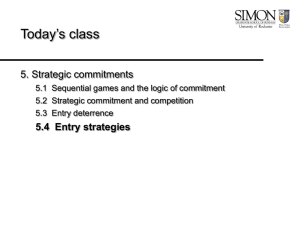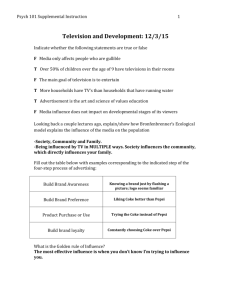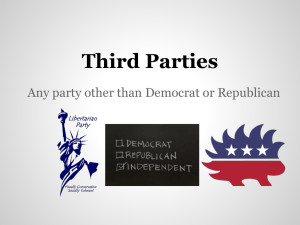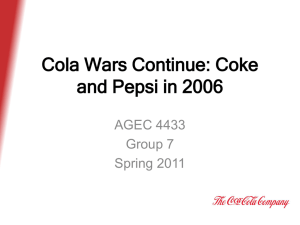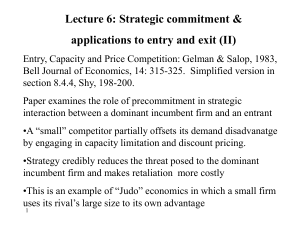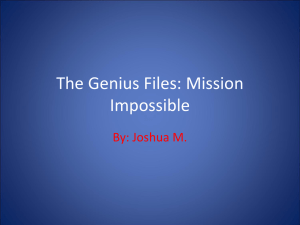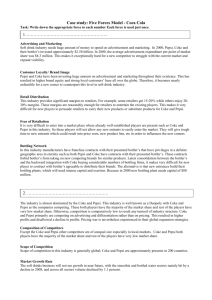Strength and Weakness in the Game of Business Adam
advertisement
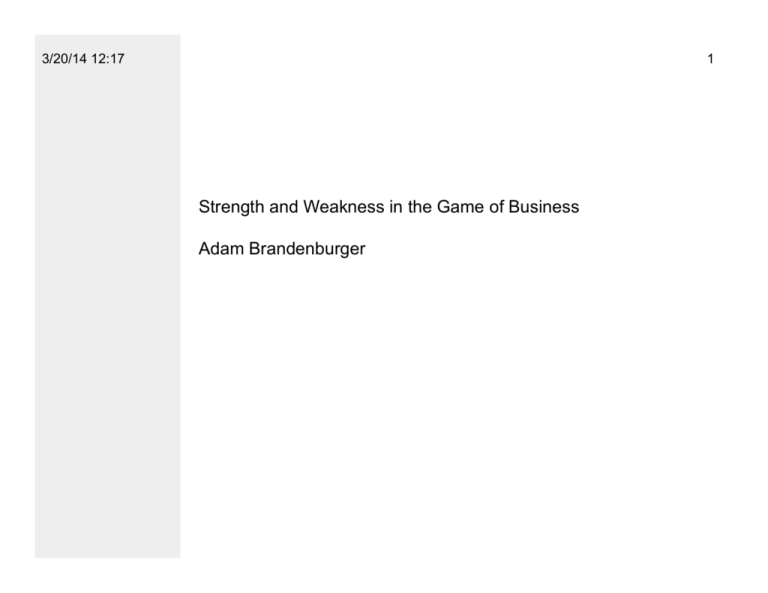
3/20/14 12:17 1 Strength and Weakness in the Game of Business Adam Brandenburger 2 Imitation Imitation (often) undermines added value So, what can one business do that another business will not imitate? This question is particularly interesting when the first business looks to be the weak player the second business looks to be the strong player 3 An Answer: Judo Strategy By putting itself in the shoes of the strong player, the weak player finds a way to turn the apparent strength of the first player into a weakness This idea is often called judo strategy Kyuzo Mifune (l) and Jigoro Kano (r) Picture: Wikipedia Origin: “Judo Economics: Capacity Limitation and Coupon Competition,” by J. Gelman and S. Salop, Bell Journal of Economics, 14, 1983, 315-325 4 Judo Strategy: Pepsi vs. Coke What was the guiding principle behind Coke’s early moves --- in the early to mid-twentieth century --- to develop its business? “In arm’s reach of desire” -- Robert Woodruff, CEO, 1923-1955 References: “Cola Wars Continue: Coke and Pepsi in the Twenty-First Century,” HBS Case 702-442; www2.coca-cola.com heritage timeline; this and the next three slides draw heavily on a conversation with David Collis Picture: Wikimedia Commons 5 Pepsi vs. Coke: The First Mover 1905-1918: Franchised bottling operations (after initially failing to see the potential) Expanded to Cuba, Puerto Rico, France, U.S. territories 1920-1928: Reached 1,000 bottlers Went with the U.S. team to the Amsterdam Olympics 1930’s: Put logo on racing dog sleds in Canada and bull-fighting arenas in Spain Developed six-pack and open-top cooler 1941-1945: “Followed the flag” with U.S. troops around the world 1940-1960: Doubled number of overseas bottlers from mid-1940’s to 1960 Reference: www2.coca-cola.com heritage timeline 6 Pepsi vs. Coke: Enter Pepsi What strategy did Pepsi use in its early days against Coke? Judo! 1934: Priced its 12-ounce bottle the same as Coke charged for its 6.5-ounce bottle (called the “kitchen cola”) 1940: Created first nationally broadcast advertising jingle (“PepsiCola hits the spot/Twelve full ounces that’s a lot/Twice as much for a nickel, too/Pepsi-Cola is the drink for you”) 1950s: Tracked the growth of supermarkets (introduced 26-ounce bottles) and suburbia --- Coke was slower, and faced channel conflict (?) 1958: Targeted young, fashionable consumers with the “Be sociable, have a Pepsi” theme (and replaced its straight-sided bottle with the “swirl” bottle) --- Coke could not copy without risking its ‘heartland’ image 1962: Launched its “Pepsi Generation” ad campaign to post-war baby boomers http://www.youtube.com/watch?v=QWQkf0w5JR4 Reference: www.pepsi.com/ads_and_history/legacy 7 Pepsi vs. Coke: Coke’s Reaction How did Coke react? It failed to! Because of the judo effect And because … Picture: Wikimedia Commons Coke did not fully recognize Pepsi as a competitor until the Pepsi Challenge (1974) In the 1960’s, it took its eye off the U.S. market and focused internationally Pepsi grew from 10% share in 1950 to 20% in 1970 Reference: www.pepsi.com/ads_and_history/legacy 8 Exercise: A Game of Judo Strategy Consider a game with one incumbent, one potential entrant, and 100 possible buyers. (The incumbent has sufficient capacity to serve all buyers.) The game unfolds in four stages: § In the first stage, the potential entrant must decide whether or not to enter the market (and incur a small entry cost). § In stage two, the entrant decides simultaneously on two things: --the number of buyers to target, and --the price for its product (the price must be the same for all its buyers). § In stage three, the incumbent responds to the entrant’s choices by deciding on a single price at which to offer its own product to all buyers. § In the fourth and final stage, buyers make their purchase decisions, and each firm serves the buyers that decide to purchase from it. Based on “Judo and the Art of Entry,” by Vijay Krishna, Harvard Business School Case, 187-165; and “Judo Economics: Capacity Limitation and Coupon Competition,” by Judith Gelman and Steven Salop, Bell Journal of Economics, 14, 1983, 315-325 9 Exercise cont’d. Each one of the 100 potential buyers is interested in purchasing one unit of product from either the incumbent or the entrant. However, only those buyers targeted by the entrant have the option of purchasing from it. To see how this works, think of the buyers as arrayed in a certain order and labeled as buyer 1, buyer 2, …, buyer 100. Suppose, as an example, that the entrant has targeted 10 buyers. Then, buyers 1 through 10 each get to decide whether to purchase from the incumbent or the entrant (or from neither). Buyers 11 through 100 each get to decide whether to purchase from the incumbent (or not at all). This second group of buyers does not have the option of purchasing from the entrant. Suppose that: (a) each buyer has a willingness-to-pay of $200 for one unit of the incumbent’s product and $160 for one unit of the entrant’s product; and (b) the incumbent has a $100 unit cost and the entrant a $120 unit cost. (The incumbent has a “dual competitive advantage.”) 10 Questions Formulate a strategy for the entrant. How much money can the entrant make? How would an added-value analysis of the game proceed? Is it the same as or different from the analysis above? 11 Analysis Accommodate 200− n×(p−120)−e (100−n)×(200−100) Incumbent Enter with n, p Entrant Fight (p + 40)− −e 100×(p+40−100) Stay Out 0 100×(200−100) max n×(p−120) subject to (100−n)×(200−100) > 100×(p+40−100) 12 Analysis cont’d. 200 $ 160 140 120 100 0 20 Value captured by entrant 60 Value captured by incumbent 100 Units Value captured by buyers #1 - #20 13 Levels of Reasoning in Judo Strategy The weak player engages in second-order reasoning It is ‘rational’ and analyzes the strong player by assuming it, too, is ‘rational’ What if this assumption is incorrect? Can we think of instances of third-order reasoning? 14 Judo Strategy: The UK Petrol Price War * In the early 1990s, UK supermarkets (Tesco, Sainsbury, Safeway, Asda) entered the UK petrol market, obtaining a 20 percent share by 1995 The strategy was simple: Offer lower prices than those offered by the major oil companies Shell, Esso, BP i. Incumbents’ decision tree Cede share Since competition among gas stations is local, the supermarkets are targeting only a part of the market ii. A price cut is expensive because the majors have large customer bases Cut price i. The supermarkets won’t keep to a small share * From: “Judo in Action,” by Ken Corts and Debbie Freier, teaching material, 05/29/02; which is based on “Esso Price-Watch,” by Amee Chande and Eleanor Hardwick, course paper, Harvard Business School, Fall 2001 15 The UK Petrol Price War: Anti-Judo Is there a third option for the oil companies? Esso responded with Pricewatch, which offered to match the lowest price offered by a rival within a two-mile radius So Esso made a targeted response The challenge for an entrant is to target part of the market in a way that the incumbent can’t Picture: Wikimedia Commons “Petrol retailers posed to ignite price war,” by Nigel Cope, The Independent, 09/18/95 16 Yuan Dynasty China (1279-1368 A.D.) During the final days of the Yuan dynasty, rebellion had broken out throughout the empire. Initially, there were several contenders vying to be the first to found a new dynasty on the imminent fall of the house of Yuan, but the field was narrowed to two: Chu Yuanchang and Chen Yifu. The two armies met at Poyang Lake where a naval engagement was to take place. General Chen had the advantage of both troops and ships. His ships were large and sturdy and he had them lined up side by side across the entire expanse of the lake. He furthermore had the ships joined together with iron chains so as to create an impenetrable barrier. General Chu sent his ships to attack but they were defeated, having failed to break through the cordon. Fortunately for Chu, the next day a violent northwest gale began to blow. Since Chen’s flotilla was situated downwind, Chu took advantage of the situation to launch fireboats against the barrier. Soon Chen’s troops were in a frenzy to save their ships from both the rising storm and the fire that was fanned into a blazing fierceness by the wind. Taking advantage of the panic and confusion that ensued, Chu launched his own fleet into the attack and they completely defeated Chen’s forces. --The Thirty-Six Strategies of Ancient China, Stefan H. Verstappen, China Books, 1999, p.57 17 A Fistful of Dollars (1964): Ennio Morricone “As budget strictures limited Morricone’s access to a full orchestra, he used gunshots, cracking whips, whistle, voices, guimbarde (jaw harp), trumpets, and the new Fender electric guitar, instead of orchestral arrangements of Western standards à la John Ford.” * http://www.youtube.com/watch?v=JaNogNtT0zA http://www.youtube.com/watch?v=PwzZBoAYX74 Picture: Wikimedia Commons (Olivier Strecker) * http://en.wikipedia.org/wiki/Ennio_Morricone 18 Totaalvoetbal: Johan Cruyff Ieder nadeel heb z’n voordeel (Every disadvantage has its advantage) --Johan Cruyff http://www.youtube.com/watch?gl=NL&hl=nl&v=U1k7DGqRF5g
